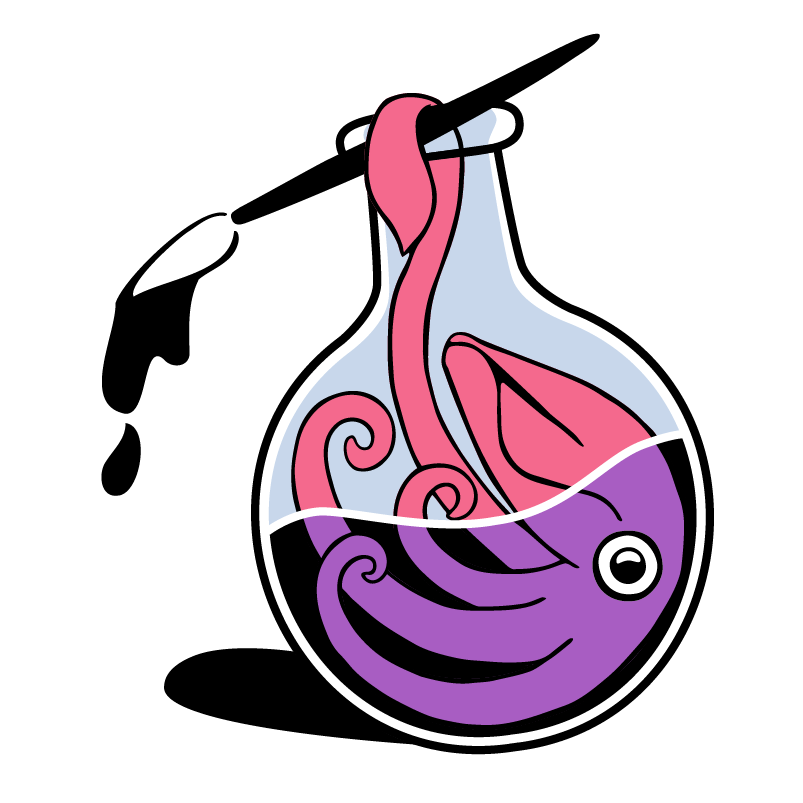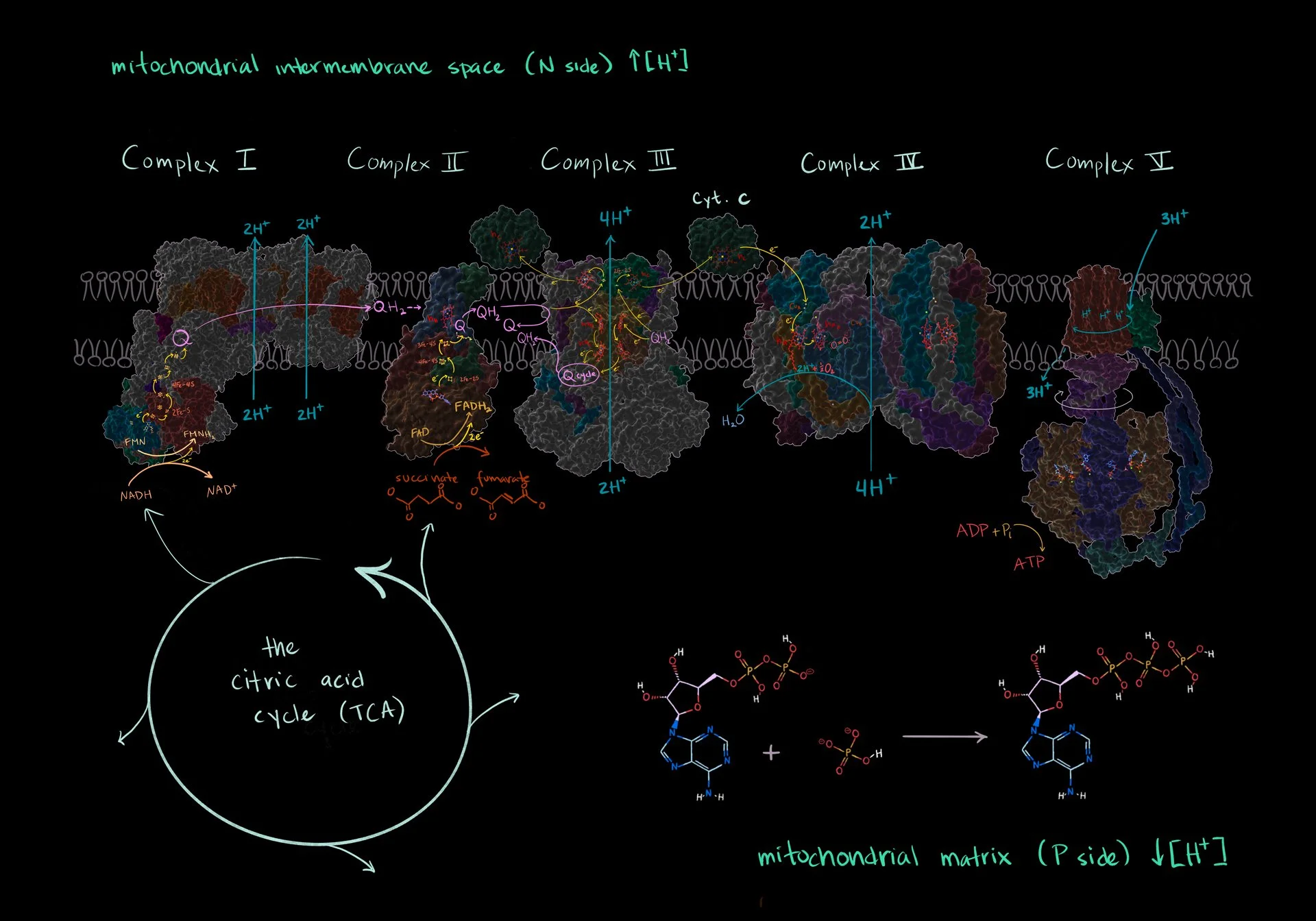Oxidative Phosphorylation
Oxidative phosphorylation, the last step of cellular respiration, takes place in the mitochondrion.
About the OXPHOS Project
The following pages on Oxidative Phosphorylation are part of my graduate dissertation. Inspired by my own difficulties in molecular biochemistry courses, I decided to create a new e-learning resource for students and anyone else struggling with learning this process. All protein models were created using data from the Protein Data Bank.
A brief overview of cellular respiration
Cellular respiration describes the set of catabolic reactions in which glucose is converted into a form that can be used to fuel metabolic reactions within the cell. In these reactions, a molecule of glucose is broken down to release energy in the form of adenosine triphosphate (ATP).
The process of cellular respiration can be represented by the overall reaction:
C₆H₁₂O₆ + 6O₂ → 6CO₂ + 6H₂O
This reaction is broken down into several smaller reactions. This allows the cell to capture energy stored in the bonds of glucose molecules more efficiently in the form of ATP (most energy is released as heat).
ATP is the molecule of energy that drives cellular processes and is made up of a sugar, ribose, a nitrogenous base, adenine, and three inorganic phosphates. It is formed through the phosphorylation (addition of an inorganic phosphate) of ADP.
Cellular respiration is composed of four major pathways.
Each stage of cellular respiration gradually breaks glucose down into smaller molecules that are reciprocally cycled through these four pathways.
Glycolysis
The first phase of cellular respiration, glycolysis, occurs in the cytosol. Glycolysis is the only step of cellular respiration that can occur anaerobically, or without oxygen. In this process, the six-carbon sugar, glucose, is broken into pyruvate, a three-carbon molecule. ATP, and NADH are also produced during this process, along with the byproduct carbon dioxide (CO2). Pyruvate will travel to the mitochondrial matrix, where it will enter pyruvate oxidation. The ATP formed during glycolysis can be used immediately by the cell, while the NADH will enter oxidative phosphorylation.
Pyruvate Oxidation
Pyruvate oxidation is the second phase of cellular respiration and takes place in the mitochondrial matrix. In pyruvate oxidation, the pyruvate formed in glycolysis is converted into a two-carbon molecule, acetyl coenzyme A (acetyl CoA), which powers the citric acid cycle. Although no ATP is formed during pyruvate oxidation, the electron carrier, NAD, is reduced to NADH and will enter oxidative phosphorylation.
Citric Acid Cycle
The citric acid cycle (TCA) is the third phase of cellular respiration, and occurs in the mitochondrial matrix. The TCA consists of eight steps and is a closed circuit - the final step of the pathway reforms the molecule that reacts in the first step. Acetyl CoA formed in pyruvate oxidation enters the TCA and energy is harvested from it through a series of oxidation-reduction reactions.
Although only one molecule of ATP is formed during this process, several intermediates are produced that are utilized in oxidative phosphorylation. NAD is reduced to NADH, which will enter the electron transport chain (ETC) at Complex I. Succinate is also produced during the TCA, and will ultimately transfer its electron to FAD in Complex II of the ETC.
Oxidative Phosphorylation
Oxidative phosphorylation is the fourth phase of cellular respiration in which the cell’s main supply of ATP is formed. It is made up of two components: the ETC and ATP synthesis. The ETC couples the oxidation of electron carriers with the pumping of protons across the inner mitochondrial matrix, forming an electrochemical gradient. The energy stored in this gradient is then used by ATP synthase to drive ATP synthesis.
Substrate-Level Phosphorylation vs. Oxidative Phosphorylation
Phosphorylation is the addition of an inorganic phosphate group (Pᵢ) to a molecule, such as ADP. Two types of phosphorylation occur in cells: substrate-level and oxidative. Substrate-level phosphorylation is the process in which ATP is directly synthesized from the oxidation of a pathway intermediate and can occur anaerobically. Glycolysis and the TCA are both forms of substrate-level phosphorylation. Oxidative phosphorylation, by comparison, utilizes the energy produced through the oxidation of organic molecules to drive the production of ATP through chemiosmosis. Oxidative phosphorylation cannot occur without the presence of oxygen and forms water at the end of the ETC.
The Mitochondrion
Mitochondria (mitochondrion, singular) are organelles found in eukaryotic cells. Often, they are referred to as a “powerhouse” because they conduct aerobic respiration, which produces energy for the cell. Mitochondria are the location of many metabolic pathways that form not only ATP, but several metabolic intermediates as well.
The inner membrane surrounds the aqueous (fluid-filled) mitochondrial matrix.
Found within the matrix are rings of mitochondrial DNA and specialized ribosomes that translate mitochondrial RNA. The matrix is also the location of many critical metabolic pathways, including pyruvate oxidation and the citric acid cycle.
The mitochondrion contains two membranes composed of phospholipid bilayers.
Between these membranes is a fluid-filled intermembrane space (IMS). The outer membrane is covered in holes called porins, which allow small molecules like ATP to exit the mitochondrion. The inner membrane, comparatively, is impermeable to most molecules except by facilitated transport. It is characterized by folds called cristae. The cristae are studded with proteins, including the ETC complexes and ATP synthase.
Learn More About Oxidative Phosphorylation:
Electrochemical Gradient
Electron Transport Chain
ATP Synthesis




